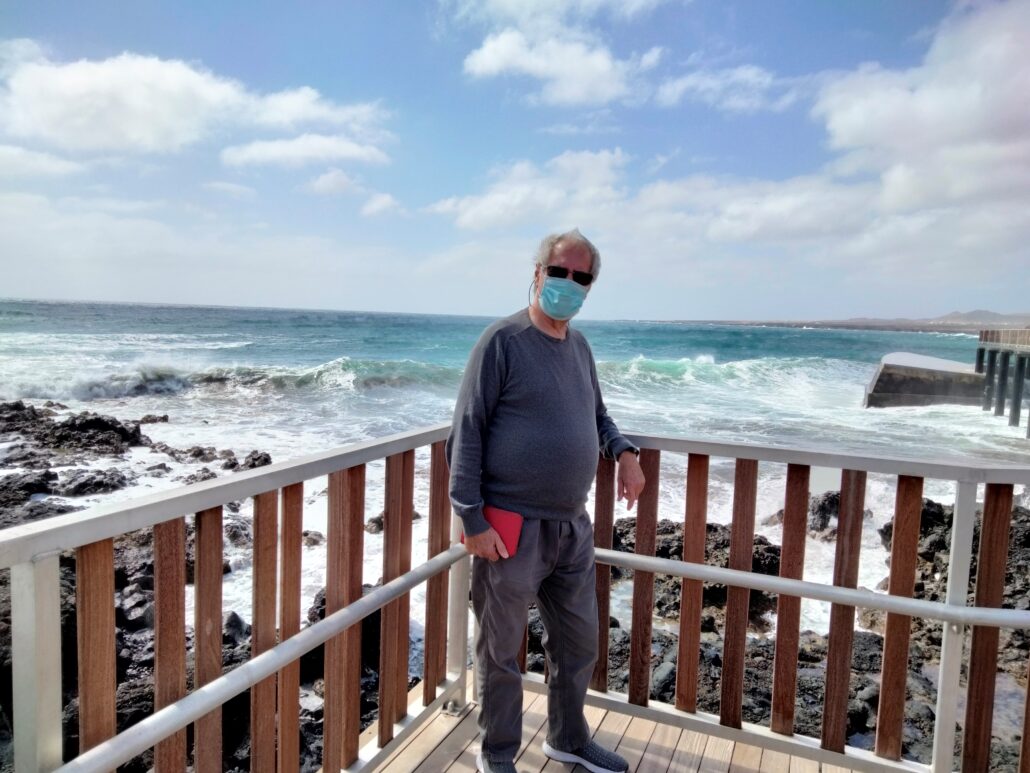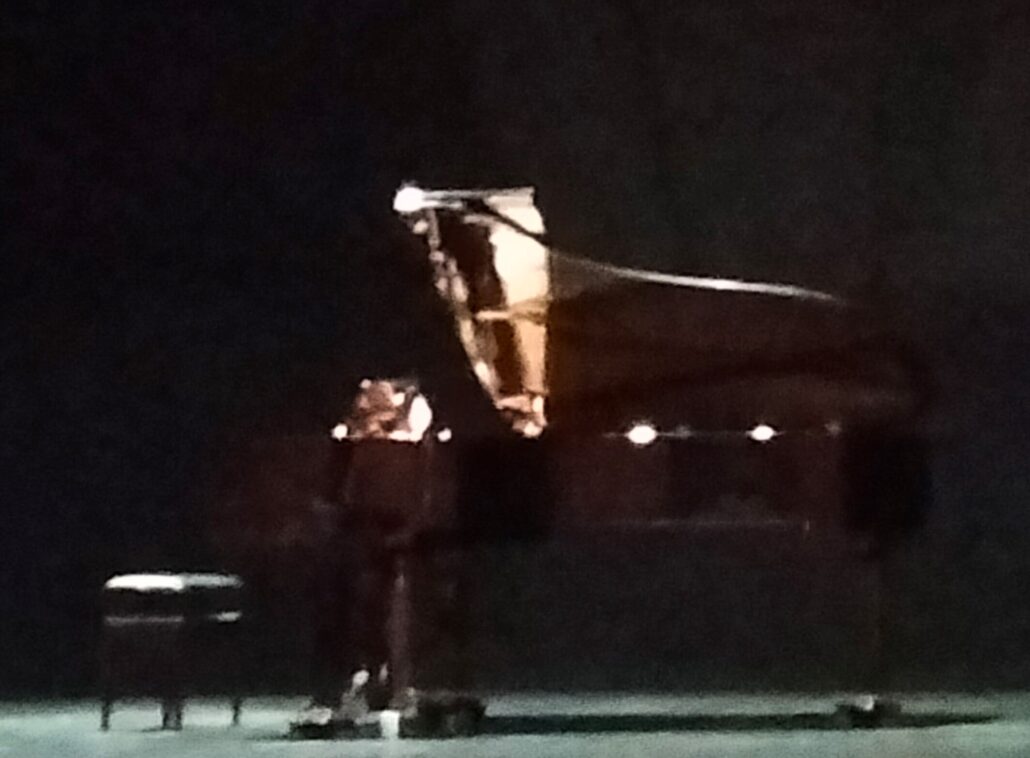MUSIC OFFERS SHELTER FROM THE STORM
MUSIC OFFERS SHELTER FROM THE STORM
by Norman Warwick
Damage to bridges and football stands occurred on Friday 14th May 2021, under heavy cloud cover and in various parts of the island there were swirling sandstorms that rendered driving hazardous, or as my wife Dee told me, my always scary driving was rendered even more hazardous than usual. These almost apocalyptic conditions seemed bent on ruining the natural beauty of our island as a thousand palm trees in the valley of Haria were bent almost double and on the shoreline down at Arrieta the waves rose monstrously high and threw themselves to explode against and over the rocks and harbour wall
Because our car was due in at our dealership in Arrecife for brake repairs we had been awoken to our six-thirty a.m. alarm, and although Dee had read out to me some of the warnings being issued on her array of technological toys, we left home an hour later in good heart. As we drove out of Playa Blanca on the LZ 2 the steering wheel demanded a firm grip and we have seen too many vehicles flipped over in the central reservation to have risked my usual light-touch, one finger control. The rolling, black clouds and the sun trying to break through them caused light and shade to dance on the mountain sides but as I foolishly glanced up to see the shadows Dee had just described as ´silhouettes dancing under a disco glitter ball´ another sudden gust reminded me of the dangers of doing so. Mindful of the cross winds we were likely to encounter on the rest of the strange two way traffic pairing of the old road and the new we call a motorway, we instead turned at Uga, having decided to follow the road through the bodegas on La Geria.
Grapes were clinging desperately to the vines as the wind tried to crush them beneath her to make them whine, sorry, to make them wine..
As we took the Circumnavigation or whatever its called towards our dealership the Oleander that separates the uphill grand prix track and the downhill were also being thrown around and seemed to be tossing out bouquets of flowers at us, from the ravaged bushes that form the central divide, as if we were a wildly swerving, even if slow moving, target they wanted to destroy.
We nevertheless arrived dead on our appointed time of 8.30 to be greeted by the wonderful cheery, busy and efficient staff at Nissan and were mighty relieved when they offered us a courtesy Nissan Centurion Tank to replace the flimsy five year old Micra we had brought in for repair.
I ought to add here that this was also the day that Lanzarote began crawling out of lockdown with some social distancing laws being eased, curfews abandoned and news of forthcoming live arts and sports events. To see whether there were crowds of people about, to evidence renewed optimism, we set off in search of them, to Costa Teguise. Crowds were there none, perhaps because the weather was worsening, and to be honest the tourist centre of the resort still looked like a ghost town.
We parked in a big town centre car park, and it only took me thirty minutes to complete my parking manoeuvre. A key that isn´t meant to be put into the ignition, a six change gear stick with reverse hidden away in it somewhere, a multiplex screen on my dashboard (which I couldn´t see because I was looking backwards trying to reverse) showing me the space I was trying to fill, which was anyway about the dimensions of a football penalty area. This ridiculous vehicle also had one of those annoying animated voices offering distracting advice in tones that were seemingly imitating my wife. Once positioned I pressed the button that turns off the engine, had to turn it on again to close the windows, click on the automatic handbrake (would you trust one?) and force open the heavy door, shouldering it like a shield against a wind that seemed hell bent on trapping us inside.
We managed to walk down to the sea front where the wind seemed slightly weaker, although tumbleweed was still hurtling around the walk way as if we were in a spaghetti western on fast forward. The sea, here, was relatively calm and we roamed beside it through the desolate streets, in unspoken agreement to head down to Casa Luis restaurant near The Lanzarote Art Gallery. For the last part of this walk we had to climb the north face of a stone stairway leading up into the commercial area of town, to our favourites breakfast bar. There were a handful of workers enjoying an early breakfast on the outside patio. These were obviously indigenous people far more used than we were to eating an omelette and sipping a coffee in a force niner. Chairs wobbled and toppled, small potted trees, still in their pots, flew low over our heads and my Tortilla Espanol danced and skittered across my plate, broke on the table and fell in pieces to the ground and the top of my cappuccino became a tsunami every time I raised it to take a drink.
So we decided to head to Arrieta for an early lunch rather than a late breakfast. We love the beachside bar there, with its wonderful views up the Tabeyesco road that seems to have been closed for repair for about two years now, across the ´bay´ to Mala and out to sea and the bridge that takes diver and fisherman out to a kind of jetty off which they can five or fish.
The first disappointment was that the Chiringuito, normally busy (even with local surfer dudes whilst the tourists haven´t been here), wasn´t open. There were no signs saying why, although they had perhaps paid more respect to the weather warnings than we had. Nevertheless as we sat down on the strange, bendy concrete bench that looks out to sea, we noticed there were people walking along the bridge that we had learned earlier that morning, from Miguel´s Lanzarote Information newsletter, had only recently re-opened. It looked an exciting walk, too, although it is only a hundred yards long.

We used to love walking it when we were holidaying here years ago, but today the waves were spuming sixty feet into the air above the heads of the end of the pier pedestrians. We waited for them to come back to land, leaving the bridge empty of walkers and decided we would give it a go. The atmosphere and the tension and the crashing spray were invigorating, and the seascape spectacular, until a lifeguard came rushing by to close off the sea-end of the walk and warning us to return, pronto, pronto, to the beach. At the age of sixty seven, my wife broke her personal best time for the hundred yard dash and even I wasn´t too far behind. When we had re-united safely on terra-very-nearly-firma we decided to drive up over the hills to Haria and then head home for lunch at Lani´s Snack Bar in Playa Blanca.
What a spectacular drive that turned out to be, with the descent into the bowl of Haria and then the drive up the tunnel road back to Arrecife affording incredible views of the storm ravaging the palm trees, and the coast line looking, from on high, as if there were hundreds of white stallions racing in on the tide.
The Pork Loin Baguette and cold beer at Lani´s, though, was lovely and with a couple of unexpected hours to kill we headed home, fed the cats, had a cat nap of our own and then headed off back to Arrecife for the first live concert held there for months. Just before doing so we checked our e mails and on line sources to make sure the concert was still on and we saw that the newly restored footbridge at Arrieta is quite badly damaged and might need to be closed again for restoration
A coffee and a coke at the Pit Stop round the corner from the theatre was. literally, an uplifting experience. The tiny corner café was crowded inside and there was a group of male teenagers milling around the front steps. Not able to find seats we asked if we could take our drinks outside, and hey presto, one of the teenage lads ´uplifted´ two chairs and a small table out into the deserted walk way for us and simply gave us a smiling de nada when we thanked him.

Half an hour later, we had sadly realised that El Salinero must have made available only a restricted number of tickets for the concert. As the lights dimmed and we looked to the stage at the piano awaiting the entrance of its player there were only thirty, very socially distanced people in the audience.
What a treat we all enjoyed, though.
As a tribute to Spanish culture and music, Luis Agius, pianist and composer, had created a special programme which he called Spain Within A Piano. This was comprised of various and significant places of our geography and, at the same time, different piano pieces by Spanish composers or music that had special connection with Spain. The collection also included original work Agius had composed relating to those places for which there was no pianistic work expressly evocative or inspired by them.
In this way, and as a musical journey, with the piano as an effective vehicle, we were given a fascinating and powerful temporal and spatial tour of Spain, covering a range of topics, moving chronologically from the eighteenth to the twenty first century.
The recital was structured, in blocks of four pieces, for piano, of about 20 minutes each, called Travels with room for the musician and composer to substitute pieces occasionally that might be particularly specific to a particular convert venue.
It was very apparent that this would continue the course of our day, of calms between storms. Agius played lovely melodies beautifully, with notes easily rolling out to us in the theatre but he also produced powerful sonorous music to recreate dramatic landscapes or events.
Spain’s political fortunes during the 18th century were played out against a background of events in the rest of Europe, and Spain no longer called the shots on a global stage, as they had, perhaps in the previous couple of centuries. Spain’s political status depended to a large degree on the struggle for power between Britain and France, its traditional rivals, and Austria, the home of the Hapsburg dynasty. At the same time, lesser powers such as Holland and Portugal were ready to pounce on any Spanish weakness. Both had historical grievances against Spain, having once formed part of the Spanish empire.
Any maps of Europe in the 18th century showed that Spain’s territory had shrunk substantially from what it had been in the 16th and 17th centuries.
Agius demonstrated this in the first quarter of the programme with the inclusion of his own compositions Valence Mediteranean and the very gentle Wind Around The Olive Tree. He also included Spanish Dance Number 2 Oriental by Enrique Granados as well as Granada by Isaax Albeniz. It somehow felt redolent of a Spain re-evaluating and re-establishing its past and identity.
The nineteenth ventury was one of three abdications in the same year, 1808 and a vicious war against Napoleon and his troops in which Spanish, French and Anglo-Portuguese troops clashed as they criss-crossed the country.
Over a sixty year period of the nineteenth century, five constitutions were proclaimed and in the second half of the century particularly, there were growing voices of worker discontent, and strong nationalist sentiments in Catalonia and the Basque Provinces.
Compared with its traditional rivals Britain and France, which were still acquiring overseas possessions, Spain went through a political and social wringer in the 19th century. .
There were thunderous notes in the pianist´s second part of the concert that were surely to reflect this instability and Arajuez Night Sonata Domenico was a powerful opening, with Agius´ own compositions, El Greco and Rilke In Toledo and The Walls of Heaven reflecting, perhaps, the country´s search for stability
Each of these two opening sections had been well received by the audience and received prolonged applause.
I was struck by how fluently Agius moved from peace to war and from chaos to calm and his wonderful and quite charismatic way of sustaining notes for a long fade into silence, raising his right arm high to ´lift´ such sounds from his instrument.

His third offering, reflective of the twentieth century, took us to areas such as Cadiz in his own Sailor´s Dream and Barcelona with his Sunset In The Park of Guell and he played a Tribute to Lorca with another of hios own works, Cordoba: Far Away And Alone. All this, of course, was a retrospective of the twentieth century.
That century saw mainland Spain made up of fifteen autonomous regions. In a tapestry of uneven pattern and size, the borders of some regions followed naturally along geographical lines whilst others were stitched by historical circumstances. The Balearic and Canary Islands were other two autonomous areas. The ongoing battle between centralization and regionalism, a constant in Spanish history, continued into the twentieth century.
Almost from the outset of the twentieth century, the three ancient pillars of power in Spain, the monarchy, church and aristocracy, had been joined by new voices that challenged them. Spain was politically unstable, as evidenced by three assassinated prime ministers in the space of 24 years full of labour strikes, uprisings, rumbling separatism from Catalonia and military repression. This all led, inexorably, to a bloody Civil War and finally a long dictatorship under General Francisco Franco, for long periods of which Spain was treated by other countries as an a pariah.
However, after Franco’s death in November 1975, a new Constitution was approved and the monarchy was restored and political and social transition achieved.
Agius brought us up to date with his fourth piece of programmes, perhaps chosen for this specific location on the Canary islands, Aguis gave us his Baja el Volcán and El fin de la Tierre, that seemed to perfectly capture our local landscape and remind us of the dramatic eruptions that created it, with this all perhaps serving as an allegorical partner to the story he had told us of Spain´s history and geography.
Perhaps this was only fancy on my part, but throughout this piece I felt the music sounded suitably subdued, but unbowed, as we have all been throughout the coronavirus that has plagued the century so far.
He then closed a marvellous concert with an epilogue that had him interpreting Folias de Espana by Scarlatti.

reading up Spanish music and history
Each of the thirty members of the public able to attend the performance had been given a well-produced pamphlet of programme notes, though because they were written in Spanish I was unable to achieve any more than a very broken overview from them. I look forward, though, to learning how to scan them into my computer and focus an on-line translation service to them.
There are more concerts now being highlighted on culturalanzarote as we mentioned last week, and as soon as I have posted this report off to Miguel we shall be going on line to book tickets for a concert by ´Chano Dominguez and Hamilton, from Holland´ at the same theatre on 21st May.




Leave a Reply
Want to join the discussion?Feel free to contribute!